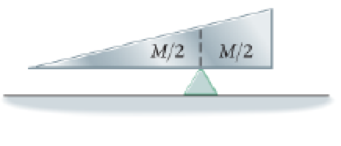
Concept explainers
Enhance Your Understanding
(Answers given at the end of the chapter)
1. Predict/Explain A piece of sheet metal of mass M is cut into the shape of a right triangle, as shown in Figure 9-24.

Figure 9-24 Enhance Your Understanding 7.
A vertical dashed line is drawn on the sheet at the point where the mass on either side of the line is M/2. The sheet is now placed on a fulcrum just under the dashed line and released from rest. (a) Does the metal sheet remain level, rotate counterclockwise (left end down), or rotate clockwise (right end down)? (b) Choose the best explanation for your prediction from among the following:
- I. Equal mass on either side will keep the metal sheet level.
- II. The metal sheet extends for a greater distance to the left, which shifts the center of mass to the left of the dashed line.
- III. The center of mass is to the right of the dashed line because the sheet of metal is thicker there.
Want to see the full answer?
Check out a sample textbook solution
Chapter 9 Solutions
Physics (5th Edition)
Additional Science Textbook Solutions
Biology: Life on Earth with Physiology (11th Edition)
Microbiology with Diseases by Body System (5th Edition)
Campbell Biology (11th Edition)
Human Biology: Concepts and Current Issues (8th Edition)
Genetic Analysis: An Integrated Approach (3rd Edition)
Anatomy & Physiology (6th Edition)
- T1. Calculate what is the received frequency when the car drives away from the radar antenna at a speed v of a) 1 m/s ( = 3.6 km/h), b) 10 m/s ( = 36 km/h), c) 30 m /s ( = 108 km/h) . The radar transmission frequency f is 24.125 GHz = 24.125*10^9 Hz, about 24 GHz. Speed of light 2.998 *10^8 m/s.arrow_forwardNo Chatgpt please will upvotearrow_forwardNo Chatgpt please will upvotearrow_forward
- No Chatgpt pleasearrow_forward3. A measurement taken from the UW Jacobson Observatory (Latitude: 47.660503°, Longitude: -122.309424°, Altitude: 220.00 feet) when its local sidereal time is 120.00° makes the following observations of a space object (Based on Curtis Problems 5.12 + 5.13): Azimuth: 225.00° Azimuth rate: 2.0000°/s. Elevation: 75.000° Elevation rate: -0.5000°/s Range: 1500.0 km Range rate: -1.0000 km/s a. What are the r & v vectors (the state vector) in geocentric coordinates? (Answer r = [-2503.47 v = [17.298 4885.2 5.920 5577.6] -2.663]) b. Calculate the orbital elements of the satellite. (For your thoughts: what type of object would this be?) (Partial Answer e = 5.5876, 0=-13.74°) Tip: use Curtis algorithms 5.4 and 4.2.arrow_forwardConsider an isotope with an atomic number of (2(5+4)) and a mass number of (4(5+4)+2). Using the atomic masses given in the attached table, calculate the binding energy per nucleon for this isotope. Give your answer in MeV/nucleon and with 4 significant figures.arrow_forward
- A: VR= 2.4 cm (0.1 V/cm) = 0.24 V What do Vector B an C represent and what are their magnitudesarrow_forward4. Consider a cubesat that got deployed below the ISS and achieved a circular orbit of 410 km altitude with an inclination of 51.600°. What is the spacing, in kilometers, between successive ground tracks at the equator: a. Ignoring J2 (Earth's oblateness) effects b. Accounting for J2 effects c. Compare the two results and comment [Partial Answer: 35.7km difference]arrow_forwardplease solve and explainarrow_forward
 College PhysicsPhysicsISBN:9781305952300Author:Raymond A. Serway, Chris VuillePublisher:Cengage Learning
College PhysicsPhysicsISBN:9781305952300Author:Raymond A. Serway, Chris VuillePublisher:Cengage Learning University Physics (14th Edition)PhysicsISBN:9780133969290Author:Hugh D. Young, Roger A. FreedmanPublisher:PEARSON
University Physics (14th Edition)PhysicsISBN:9780133969290Author:Hugh D. Young, Roger A. FreedmanPublisher:PEARSON Introduction To Quantum MechanicsPhysicsISBN:9781107189638Author:Griffiths, David J., Schroeter, Darrell F.Publisher:Cambridge University Press
Introduction To Quantum MechanicsPhysicsISBN:9781107189638Author:Griffiths, David J., Schroeter, Darrell F.Publisher:Cambridge University Press Physics for Scientists and EngineersPhysicsISBN:9781337553278Author:Raymond A. Serway, John W. JewettPublisher:Cengage Learning
Physics for Scientists and EngineersPhysicsISBN:9781337553278Author:Raymond A. Serway, John W. JewettPublisher:Cengage Learning Lecture- Tutorials for Introductory AstronomyPhysicsISBN:9780321820464Author:Edward E. Prather, Tim P. Slater, Jeff P. Adams, Gina BrissendenPublisher:Addison-Wesley
Lecture- Tutorials for Introductory AstronomyPhysicsISBN:9780321820464Author:Edward E. Prather, Tim P. Slater, Jeff P. Adams, Gina BrissendenPublisher:Addison-Wesley College Physics: A Strategic Approach (4th Editio...PhysicsISBN:9780134609034Author:Randall D. Knight (Professor Emeritus), Brian Jones, Stuart FieldPublisher:PEARSON
College Physics: A Strategic Approach (4th Editio...PhysicsISBN:9780134609034Author:Randall D. Knight (Professor Emeritus), Brian Jones, Stuart FieldPublisher:PEARSON





